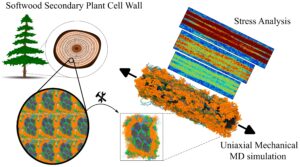The plant cell wall (PCW) is a remarkable biomaterial endowing plants with strength, stiffness, and defense against pathogens and chemical agents. This complex structure, mainly composed of cellulose in a matrix of hemicellulose, lignin, and water, exhibits impressive mechanical properties. However, the link between its molecular architecture and macroscopic mechanics is not fully understood. This study uses molecular dynamics simulations to examine the nanomechanical behavior of spruce wood’s S2 layer. Multi-component models including cellulose, hemicellulose (xylan and mannan), lignin, and water were developed. Simulations showed that water acts as a “molecular lubricant,” mediating critical interactions between the components of the system. Tension and compression tests on the models displayed realistic mechanical behavior. Our results show that cellulose microfibrils bear the primary load, while lignin dissi- pates stress under compression. These findings offer new insights into the relationship between molecular structure and mechanical function in this complex biomaterial.

Unraveling the Mechanical Behavior of Softwood Secondary Cell Walls through Atomistic Simulations Lucas N. Trentin, Amadeus C. S. Alcântara, Carlos G. T. Batista, and Munir S. Skaf Biomacromolecules 2025 26 (6), 3395-3409
https://doi.org/10.1021/acs.biomac.4c01806

